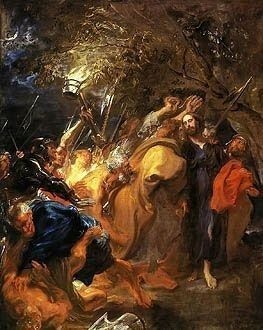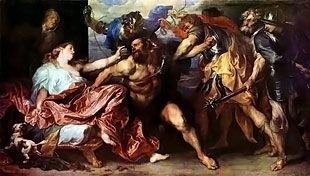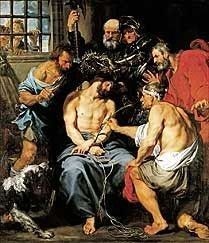|
ANTHONY VAN DYCK | |||||
Anthony Van Dyck Gallery of Royalty Free Images Art Works in High Resolution. Art and Artist study of Van Dyck biblical paintings. Always Royalty Free |
Incident to his association with Rubens, Van Dyck and his fellow students are said on one occasion to have entered the master's painting room during his absence and to have inadvertently jostled and injured Rubens' great "Descent from the Cross", in course of completion. They were in consternation. Van Dyck was persuaded to endeavor to remedy the injury to the picture. But the keen eye of Rubens detected the work of another hand, and on questioning his pupils was so pleased with the frank acknowledgment made by Van Dyck, and so well satisfied with the restoration, that he made no further comment on the matter. The arm of the Magdalen and the throat and chin of the Virgin are the parts said to have been restored by Van Dyck. Sojourning for a time in Genoa, Italy, Van Dyck, although less than twenty-five years old, painted fifty odd portraits still to be seen in the Rosso Palace and in Genoese galleries that are accounted among his masterpieces. On his return to Antwerp he met with immediate favor and was appointed painter to the Archduchess Isabella. Marie de Medici, driven from France, visited him in his studio; and the Flemish, Spanish and French nobility coveted the honor of being painted by him. Presently, he was attracted to the Court of Charles I at Whitehall, London, and so pleased that monarch with a large picture of the royal family, now in the Gallery of Windsor, that his fortune was made. He was appointed painter to the Court, received the honor of knighthood, and was granted an annuity of 200 pounds sterling. Horace Walpole records that Van Dyck was sumptuously lodged at Blackfriars, with a summer residence placed at his disposal in the country, and both the king and queen employed him constantly. Nearly forty portraits of Charles I and more than thirty-five of Queen Henrietta were painted by Van Dyck. With three hundred and fifty of his works to point to, England undoubtedly can boast of the finest collection of his paintings. Van Dyck was at the peak of his creative career at forty. From that year there is a perceptible decline in the quality as well as quantity of his work. In fact, the last two years of his life were spent entirely in travelling with his young wife, the granddaughter of Lord Ruthven M. Guiffrey states that excess of work, perhaps also excess of indulgence at the table, was the cause of his premature death at forty-two. As Fromentin, the French critic, says, "The order of precedence which should be given him in the procession of great men has never been exactly determined, but since his death, as during his life, he seems to have retained the privilege of being placed near the throne, and of being a distinguished presence there." Navigation and Searching – Terms of Use – Contact Us |



